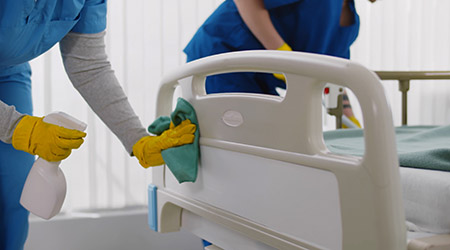Consistent terminology is not only important at scientific levels, but also vitally important for communicating with those on the frontlines of infection prevention, the environmental services associates (ESA). When educating ESAs, it is essential that we use terms that are easily understood. But it is also important that your written policies and procedures use the similar, professional terminology that is unique to our profession.
Cleaning
The unqualified use of the term cleaning should be avoided in communicating hygiene practices with cleaning staff. Terms other than cleaning could be used to define this process and state of hygienic cleaning — hygienically clean — cleaning and disinfection — process or processing.
I propose replacing “clean” or “cleaning” with “hygienic cleaning” to refer to any process intended to reduce the numbers of pathogens on surfaces to an acceptable safety target level which makes it fit for purpose, and “hygienically clean” to define the state of that surface after hygienic cleaning.
Efficacious hand hygiene involves these elements: clean running water; soap; agitation; time; attention to places where germs might hide; thorough rinsing with water; and drying with a clean paper towel.
What is true of hand hygiene should be true of environmental hygiene.
When it comes to professionally cleaning surfaces, we need to get rid of the phrase “clean when visibly soiled.” Increasingly, the data show that potentially unsafe levels of pathogens can remain on visibly clean surfaces. Fecal matter the size of a pinhead contains sufficient infective material to transmit C. difficile. When your staff is given the instruction to clean visibly soiled touchpoint surfaces, are they looking for soil the size of a pinhead? No. That is why you should eliminate that term from your education and training along with policies and procedures.
It needs to be made clear that in hygiene practice, a surface can only be judged to be safe if it has been subjected to a validated hygiene process which has been carried out in the prescribed manner. Visible cleanliness alone is not sufficient to judge whether a surface is safe.
Both the CDC and the EPA state that surfaces should be cleaned before applying disinfectants.
Process/Processing
The term process includes cleaning and disinfecting a piece of patient-care equipment or a patient-care area using micro-denier cloth or flat mop as appropriate and a hospital-approved disinfectant. We don’t clean a patient’s room. We process a patient’s room. We don’t clean an operating room; we process the operating room.
Disinfectant
A disinfectant is a substance, or mixture of substances, capable of destroying or irreversibly inactivating pathogenic — disease causing — organisms, but not necessarily spores, present on a hard, non-porous surface. It is recommended that only hospital-grade disinfectants be applied to pre-cleaned surfaces. All disinfectants sold in the United States shall have an EPA registration number because chemical disinfectants fall under the FIFRA (Federal Insecticide, Fungicide and Rodenticide) regulations. Just because the EPA registration is on a label does not mean it is safe to use. Read and follow label instructions for use, necessary PPE, mixing, contact time, kill claims, hazard warnings, water hardness, etc.
It is recommended that the surface is rinsed with clear water after the contact time has been observed. Many disinfectants are corrosive to surface materials and need to be rinsed. Also, most disinfectants leave a visible residue on the surface that should be removed.
Most authors lament the lack of cheap non-toxic effective sporicide but reality in simple mechanical removal is all that is required. Too much reliance is placed on miracle ‘kill-all’ disinfectants.
Disinfecting
The CDC’s definition of disinfecting works by using chemicals to kill or greatly reduce germs on hard nonporous surfaces. It describes a process that eliminates many or all pathogenic microorganisms, except bacterial spores, on inanimate objects. In healthcare settings, objects usually are disinfected by liquid chemicals called disinfectants.
Factors that affect the efficacy of disinfection include: prior cleaning of the object; soil load present; type and level of microbial contamination; concentration of and exposure time to the germicide; physical nature of the object (e.g., crevices); and the presence of biofilm.
Removing soil
Washing or scrubbing a surface physically removes soil and, with the soil goes the germs. The guiding principle is always to remove germs if possible, rather than kill them. When necessary, use the least amount of the mildest chemical or other product that will do the job, because stronger often means more toxic to people and more corrosive to the surface being processed.
Environmental contamination by C. difficile is now well accepted as a risk factor for the acquisition of C. diff. It is likely that the frequency of environmental spread, together with the prolonged life of spores, explains the difficulty in eliminating C. difficile once it has become established in hospitals. Vacuuming up dust from floors is probably one of the best and simplest methods to remove spores from the environment. Buffing and mopping may only serve to spread them around an even wider area.
J. Darrel Hicks, BA, MESRE, CHESP, Certificate of Mastery in Infection Prevention, is the past president of the Healthcare Surfaces Institute. Hicks is nationally recognized as a subject matter expert in infection prevention and control as it relates to cleaning. He is the owner and principal of Safe, Clean and Disinfected. His enterprise specializes in B2B consulting, webinar presentations, seminars and facility consulting services related to cleaning and disinfection. He can be reached at darrel@darrelhicks.com, or learn more at www.darrelhicks.com.

 Healthcare Is the New Retail
Healthcare Is the New Retail Bridgeway Behavioral Health Services Launches Campaign to Renovate Health Center
Bridgeway Behavioral Health Services Launches Campaign to Renovate Health Center Ground Broken for New North Dakota State Hospital
Ground Broken for New North Dakota State Hospital AI Usage for Healthcare Facilities
AI Usage for Healthcare Facilities Ground Broken on Pelican Valley Senior Living Modernization Project
Ground Broken on Pelican Valley Senior Living Modernization Project